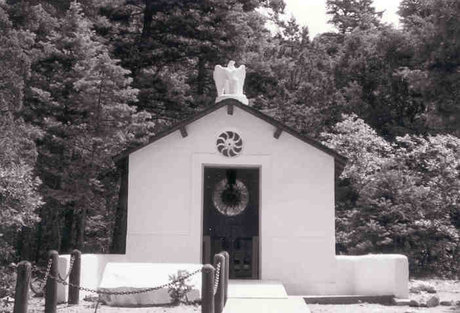Historical Significance Narrative -- LAWRENCE BIOGRAPHY
National Register Nomination for the D.H. Lawrence Ranch
SECTION 8: Narrative Statement of Significance, Continued


3. Background Biography
David Herbert Lawrence was born ON September 11, 1885, in Eastwood, England. He was the son of a coal miner, growing up amid domestic strife and the ugly environment of an industrial colliery town. In his youth, he often escaped to the beautiful countryside where he studied the local plants and flowers that would later take on symbolic meaning in his works. He spent many days at the neighboring Haggs Farm, developing a special bond with Jessie Chambers (Miriam of Sons and Lovers), who encouraged and critiqued his poetry, discussed books and philosophy with him, and helped him to grow intellectually. Due to these happy associations, farm life came to represent for Lawrence an idealistic lifestyle where humanity was intimately connected to the landscape.
Because he was a bright yet frail and sensitive boy, it was soon apparent that Lawrence was unsuited for work in the mines or factories. Encouraged by his mother, a former teacher, he began training to become a schoolteacher. He won a scholarship to Nottingham High School and later attended Nottingham University College where he earned a teacher's certificate in 1908. Lawrence then took a teaching position for Standard IV (or 4th grade) at Davidson Road School in Croydon and simultaneously worked on his first novel, The White Peacock (1911). Despite remarkable success as a teacher, early bouts of pneumonia, suspected to be tubercular, closed off that means of support and thus launched Lawrence full‑time into his writing career. What he lacked in hardiness, he made up for with his acerbic wit and powerful, rhythmic prose style. On the practical side, his mother taught him to be handy at household chores‑‑skills that would later benefit him in the rustic setting of the Kiowa Ranch.
Unfortunately, his beloved mother became ill just as he was gaining success from his writings. Lydia Beardsall Lawrence was a refined woman of Puritan values who doted on Lawrence. Marital discontent and reduced social standing (because of her marriage to a coal miner) resulted in her constant effort to propel the family back into the middle classes. Her painful death in 1910 created in Lawrence an emotional trauma that sent him reeling. Soon after, he suffered a major illness that almost claimed his life. Relations with his father continued to be strained. Arthur John Lawrence, a down-to-earth man, had little appreciation for intellectual pursuits. And yet Lawrence’s writing was drawing the attention of such notables as Ezra Pound, Edward Marsh, Amy Lowell, and Edward Garnett. He was being courted by both the Georgian poets and the Imagists. The editor of the English Review, Ford Madox Hueffer (Ford), after reading Lawrence's short story "Odour of Chrysanthemums" with its realistic portrayal of working class life, proclaimed him a "Genius."
It was during this transitional phase that Lawrence met the free‑spirited Frieda Weekley, who was married to one of his language professors. She was born in the garrison town of Metz, Germany, on August 11, 1879. She was of aristocratic German descent and a distant cousin of Manfred von Richthofen, the "Red Baron" flying ace. Her father Baron Friedrich von Richthofen served as an officer in the Franco‑Prussian War, earning an Iron Cross, and later did bureaucratic work as a civil engineer. He indulged her wild "tomboy" ways and she became his adoring "daddy's girl." Frieda received her education in a Roman Catholic convent school in Metz and attended Hans Eichberg girls' finishing school near Freiburg for one year. She met her first husband, Ernest Weekley, in 1898 while he was on a brief vacation in the Black Forest of Germany. They married a year later when Frieda was only twenty and he, fourteen years older. She had three children with Weekley: Charles Montague, Elsa Agnes, and Barbara Joy. But she found her marriage to be empty and unsatisfying, Weekley to be staid and restrictive, and the English university sphere much too conventional.
Thus the relationship between Lawrence and Frieda developed quickly, and in 1912 they eloped to Germany. During their "honeymoon" period together, Lawrence put the finishing touches on his autobiographical novel, Sons and Lovers (1913), which was destined to become a modern classic. And he wrote his first collection of travel essays, Twilight in Italy (1916), inspired by their adventurous journey to Italy where they temporarily settled. Lawrence and Frieda were married in July of 1914 in Kensington after Frieda finally secured a divorce. In 1917 Lawrence published his third poetry collection Look! We Have Come Through!‑‑a chronicling of the struggle for harmonious relations with Frieda, as well as a celebration of love and marriage.
The elopement had caused a scandal, however, and Weekley refused to allow Frieda visitation rights to her children. This was to become a sore spot in the Lawrences' marriage, especially as Frieda never conceived children by Lawrence. But no children meant they were free to travel at whim without need to set down roots. This constant roaming provided Lawrence with a continuous flow of stimulation by way of new environments, cultures, people, and ideas to spark his writing. He never felt compelled to own property, even insisting that the Kiowa Ranch be put in Frieda's name.
The couple began to socialize with society's intellectual and literary elite: Herbert and Cynthia Asquith, Lady Ottoline Morrell, Richard Aldington and his wife H.D., Bertrand Russell, and E.M. Forster. However, Lawrence's next novel, The Rainbow (1915), was banned for its frank portrayal of sexual relations and opposition to the developing military-industrial society. They moved to Cornwall (followed by their new friends John Middleton Murry and Katherine Mansfield), where Lawrence wrote much of Women in Love(1920) but had trouble finding a publisher. World War I was raging; and Lawrence, judged unfit for military service and labeled a controversial writer, was now additionally accused of spying due to his choice of a German wife.
And so Lawrence entered his wandering phase‑‑alienated from his own country, he visited Italy, Sardinia, Ceylon, Australia, and the South Sea Islands‑‑but always he yearned for America. He'd read about the "Land of the Red Indians" from James Fenimore Cooper's Leatherstocking books. The New World offered hope and tolerance to a man that had grown weary of Europe's mistreatment and misunderstanding of him. In a letter to Catherine Carswell dated November of 1916, Lawrence wrote:
I know now, finally:
- That I want to go away from England for ever.
- That I want ultimately to go to a country of which I have hope, in which I feel the new unknown.
In short, I want, immediately or at length, to transfer all my life to America. Because there, I know, the skies are not so old, the air is newer, the earth is not tired. (Letters 3:25)
In preparation for a transfer of body and soul to America, he wrote a book of critical essays that would later become Studies in Classic American Literature (1923), which is considered one of the first serious analyses of American Literature‑‑examining such authors as Cooper, Benjamin Franklin, Walt Whitman, Nathaniel Hawthorne, Herman Melville, and Edgar Allan Poe. While in New Mexico, Lawrence rewrote the essays in a distinctly "American" style—snappier and punchier‑‑targeting the American market, which he believed held his future.
Narrative by Tina Ferris & Virginia Hyde
(2004)



